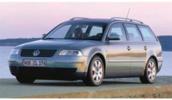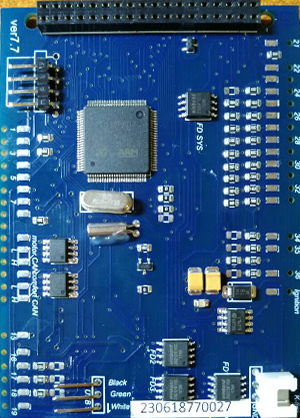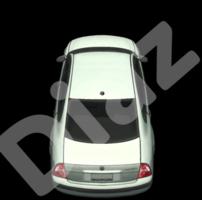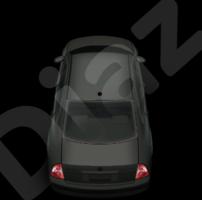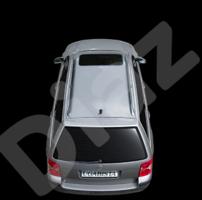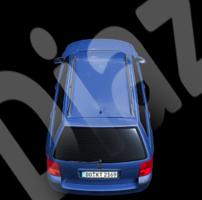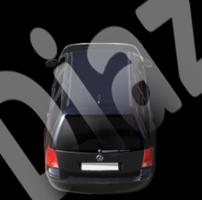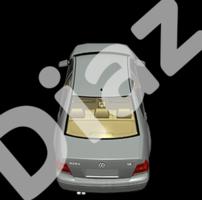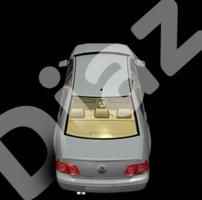 |
Saprankov |
|
Diaz |
You will need:
|
Safety
precautions
DO NOT! |
|
 |
ATTENTION!!!
When installing a color MFD, there are 3 most important points.
1. You need to configure the
power supply to 5.5v.
The MFD operates at a voltage of
5.5v.
When you connect the power supply to the MFD
you should make sure that the output
of the contacts is 5.5v,
otherwise it will damage the processor! Paragraph
18
2. It is necessary to cut the
power paths going to the pins 23 24 25,
then check that they are not voltage-free, you need to supply power
to the cluster
and check with a tester, one probe into the ground of the second to
each pin 23 24 25. Should be 0v .
Paragraph 10
3. You need to rinse all the
soldering points. Install very carefully.
After soldering the wires, it is essential to rinse the soldering
points with special flushing agents
or isopropyl alcohol. During washing, do not allow alcohol to enter
the display or under the display and its board!
1.
Disassemble
the cluster.
With a
screwdriver torx T10, unscrew the two screws edges
on the rear of the instrument panel.


Bend
all the latches neatly remove the front of the case with glass
View from above

Bottom view


1. Remove
the arrows (scroll counter-clockwise and simultaneously pull
ourselves).
Either Using
knives for oil or spatula, shoot the arrows from their shafts. It
is necessary to put
A
cardboard or napkins between the nomes and the base of the device to
avoid damaging it. Necessary
Pull
the arrows up to yourself.

2. Then
remove the substrate.

3.
Cut
the jumpers, we work carefully, so as not to damage the board.

It
should look like this:

5. Remove the excess.
On clusters with fullFIS, a temperature sensor is installed, it can
be removed with a soldering iron
or simply cut off the sensor tape
in any convenient place so that it does not interfere
later.

It is necessary to remove the display by gently
heating the loop with which it is soldered to the board,
do not tear
off the display as you can damage the dashboard board.


6.
With
the help of pliers we bend the metal clamps restraining
fullFIS display.


7.
Remove
the white diffuser. On
the back of the board, are visible white plastic latches,
bend them with your fingers and take out the
white plastic
The basis of the display.

8. We
solder the plume of the standard display and remove it.
On
some instrument panels, the plastic base of the
OEM FIS is
soldered to
the board quite seriously,
to dismantle it is best to remove the tin
from
using a soldering iron and a special vacuum.


9.
Then
you need to remove all the LEDs that are were under the standard display


We
make sure that there are no jumpers made of tin.
After
removing the LEDs, clean the board of the residues of tin and rinse with alcohol
10. VERY IMPORTANT:
For instruments with a
halfFIS or fullFIS installed, it is necessary to
find and cut
tracks from the pins of the control of the standard
FIS
on the board
of the instrument panel (from the pins 23, 24, 25 of the green
connector)
After
need to check that the 23, 24, 25
pins were 0v
Below are photos from some instruments.
On your device, the tracks may be located elsewhere
For dash have noFIS,
you just need to check that the 23, 24, 25
pins were 0v

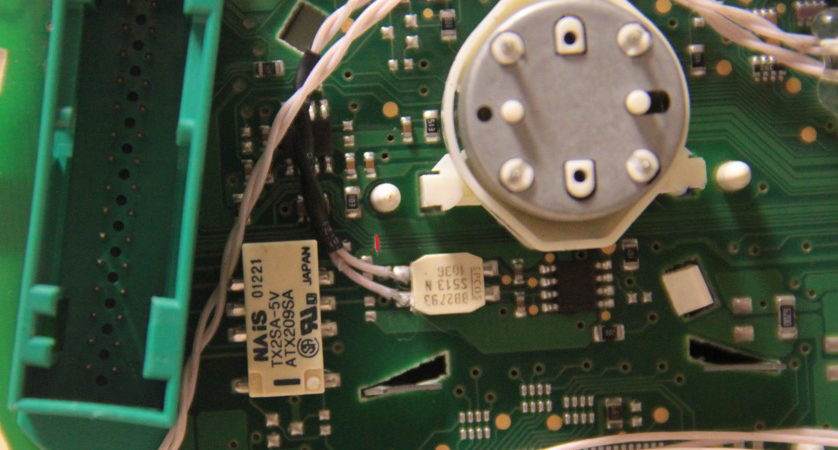
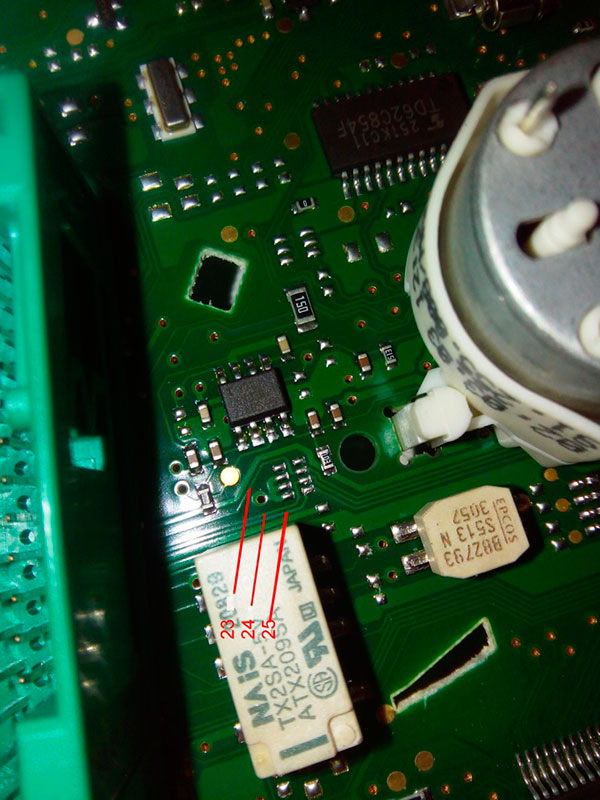
Instrument panel from Octavia with BK in
the screen under the tachometer.
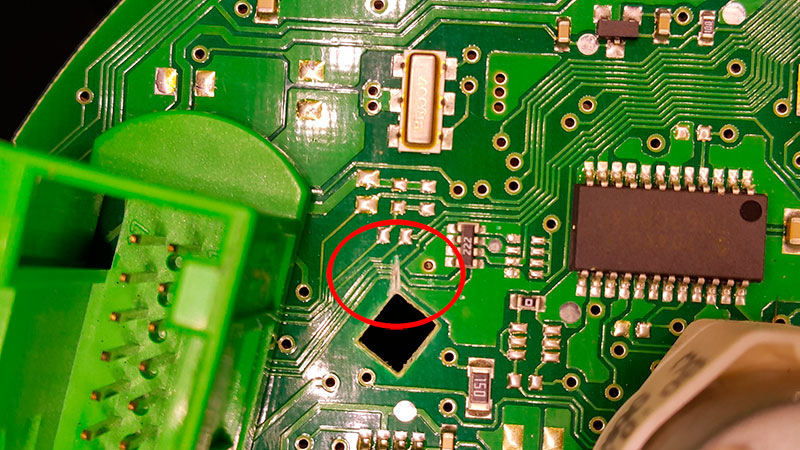
10. We
start to build wires according to the table. Wires
are cleaned of
Isolation and
twisting, ludim and cut off excess.



12. Through the
holes in the board of the device, we extend the wires to the blue
And green
connectors.

Attention!
Before installation,
check for MFD board
may have errors.
1. On the board ver.7.7 there is an error on silk-printing.
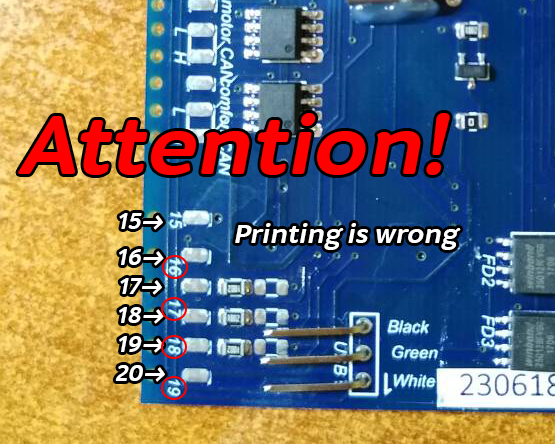
2. On the
ver.7.7
board, there is no
3-kOmh
resistor (302) at 35 pin MFD, it must be added,
You can take such a resistor on the MFD board, unsolder on a pin
that is not used and solder to 35 pin MFD
(Brake Liquid Level)
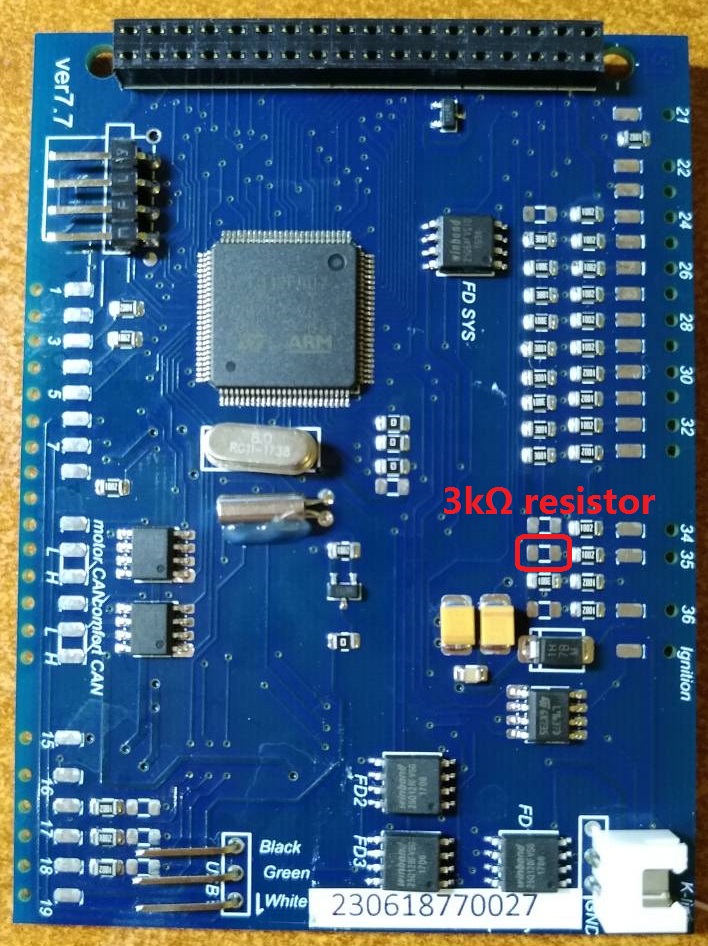
If your MFD is already installed in the instrument panel,
and putting a resistor in place does not solve the problem with a
low level of brake fluid,
You need to transfer this wire from 35 pin MFD to 16 pin MFD.
3. On the reverse side of the MFD, a capacitor was mistakenly
installed instead of a resistor to 10 kOhm,
The capacitor needs to be soldered, and in its place a 10 kΩ
resistor should be soldered.
You can take such a resistor on the MFD board, solder on the pin
which
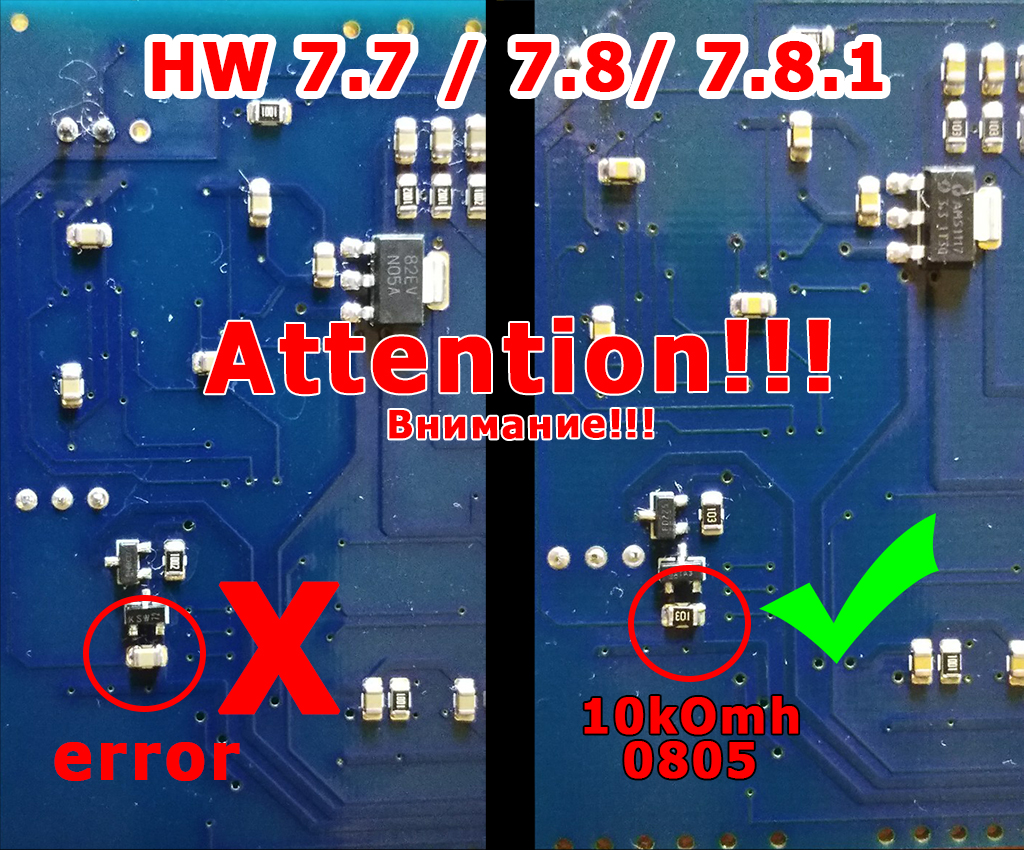
13. Using the
tester, we find the wires we need and solder them to the feet
connector
according to the table.
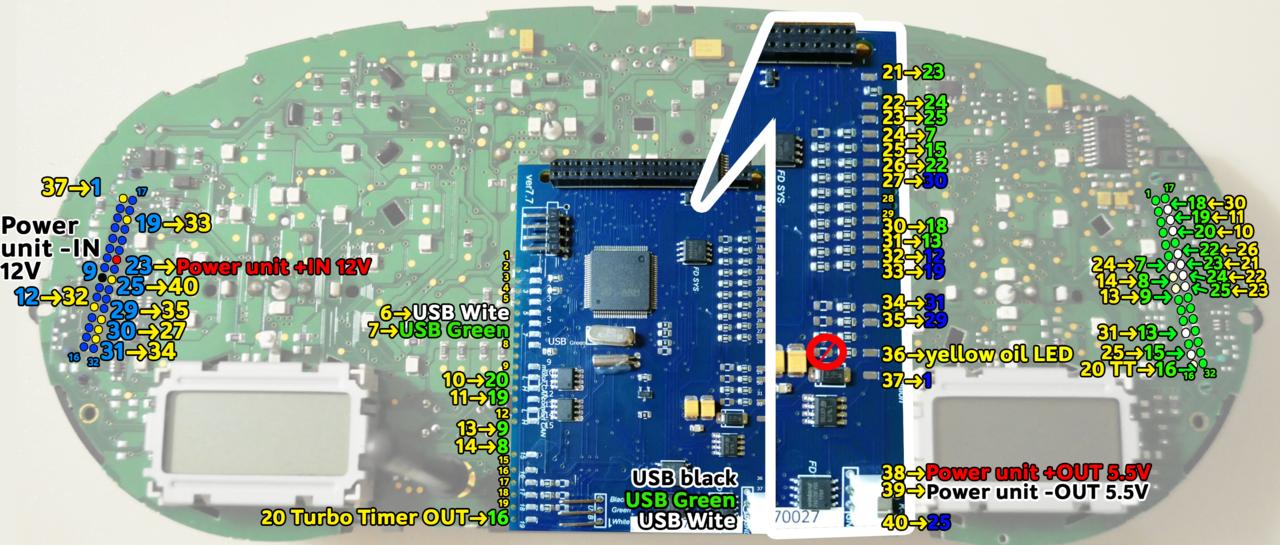
Full size
image

It is necessary to twist the wires of the
connection to the CAN-bus into a spiral.
8 pin
Green connector; 9 pin
Green connector; Comfort CAN bus
19 pin Green connector; 20 pin
Green connector. CAN-bus motor
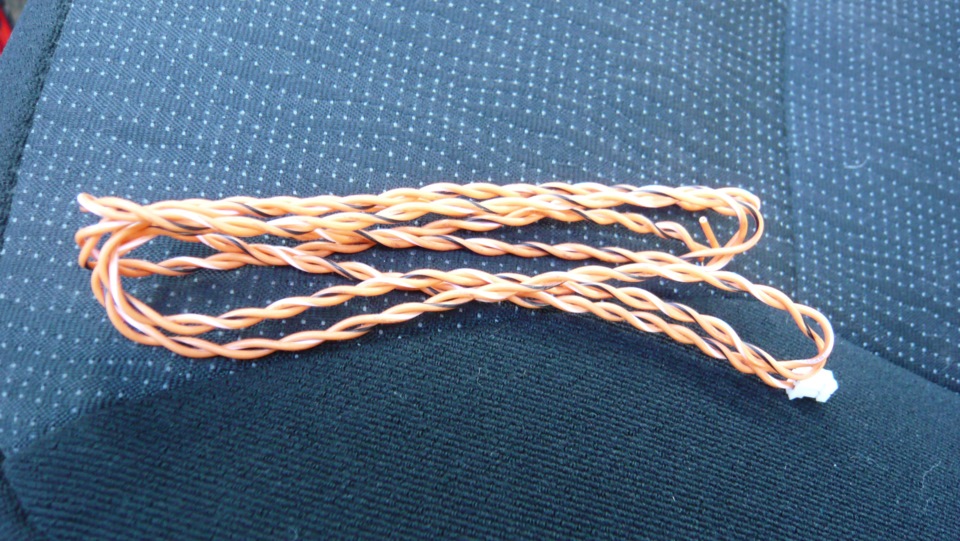
You can
choose where to solder Can-Bus wires.
1-st
way to soldering
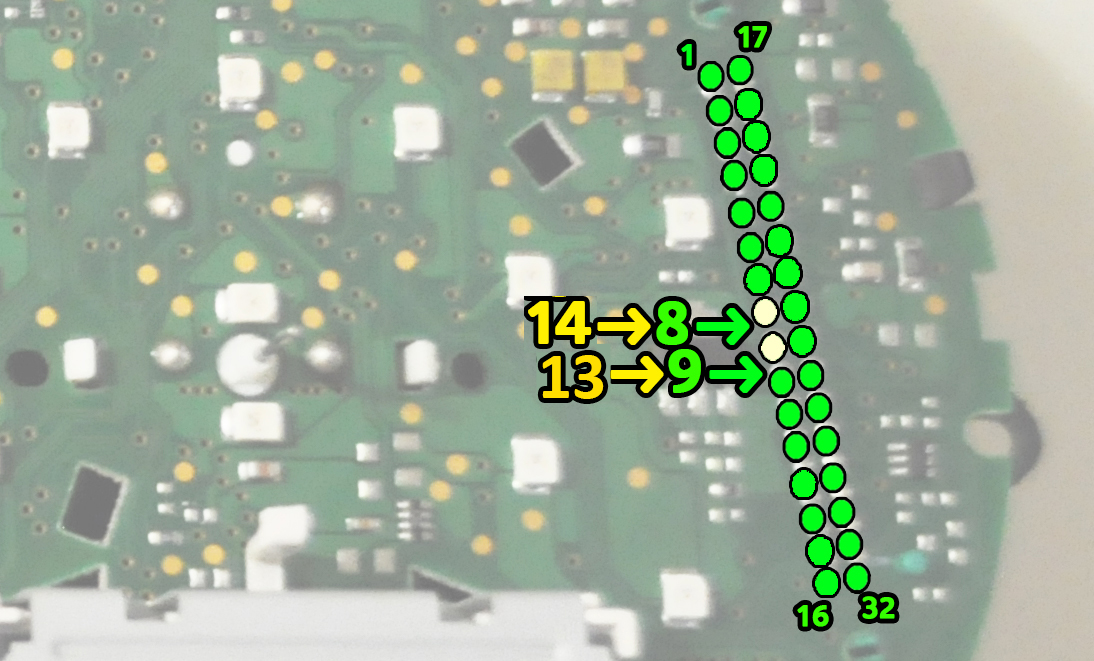
OR
Also, for
ease of installation, it is possible to solder the wires either
according
to the diagram above or from the back of the instrument
panel chamber.
2-nd way to
soldering
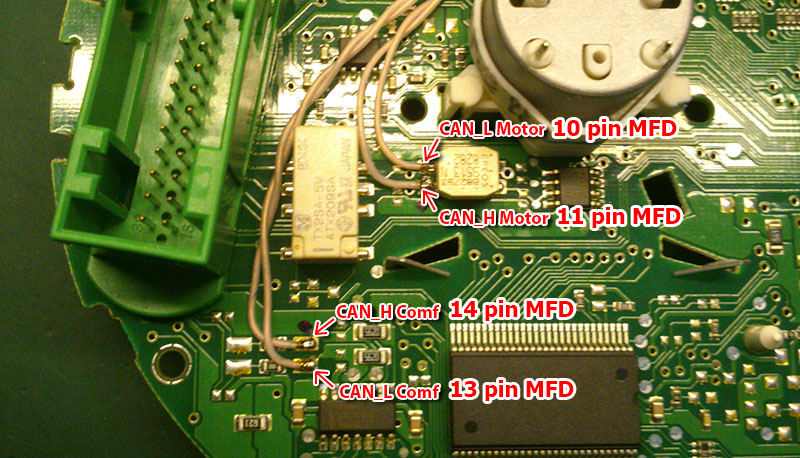
Lay the wires in such a way that they
do not interfere with the installation of white
Light diffuser.





14. On
the cluster without FIS
and with halfFIS it is
necessary to
solder the wire from the 36 pin of MFD
board to catod of yellow oil LED on the
dashboard.
And on the instrument panel with a FullFIS, this wire
does not need to be soldered!
The dashboard with noFIS looks like this:
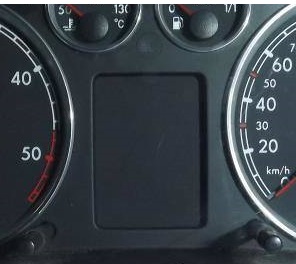
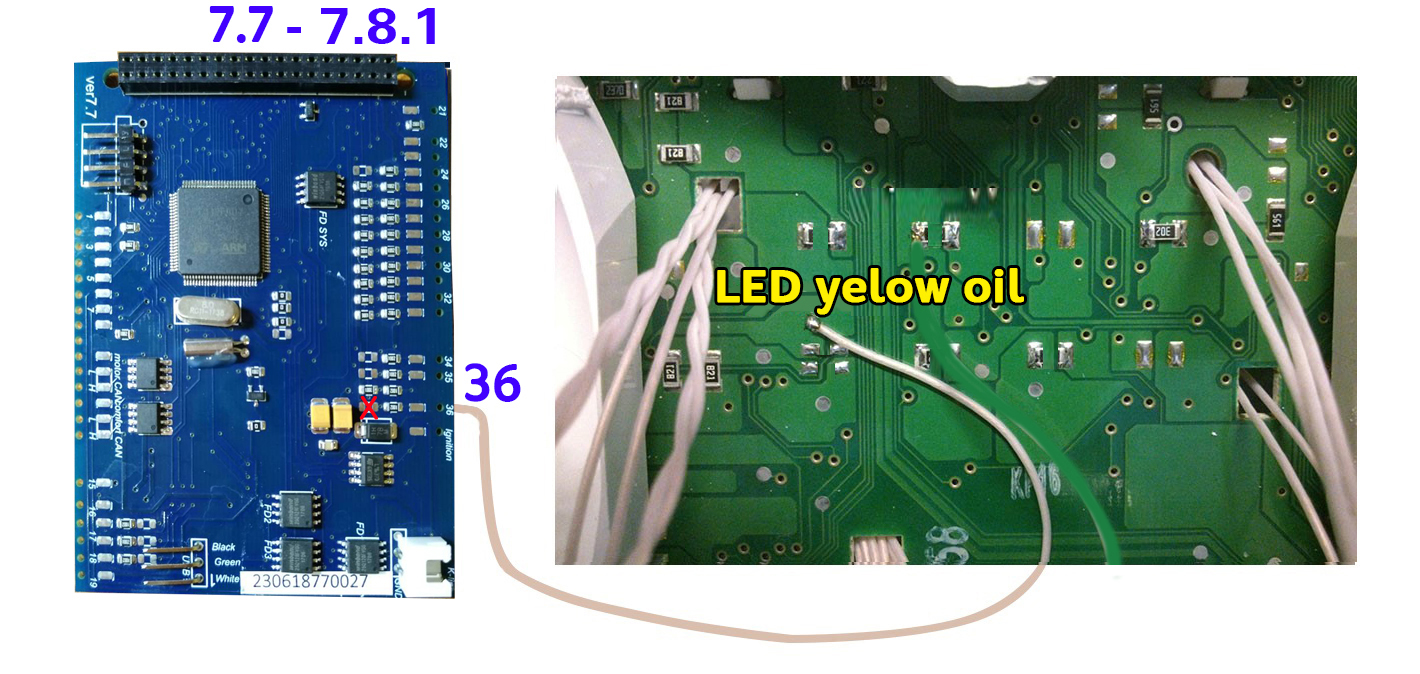
The dashboard with halfFIS
looks like this:
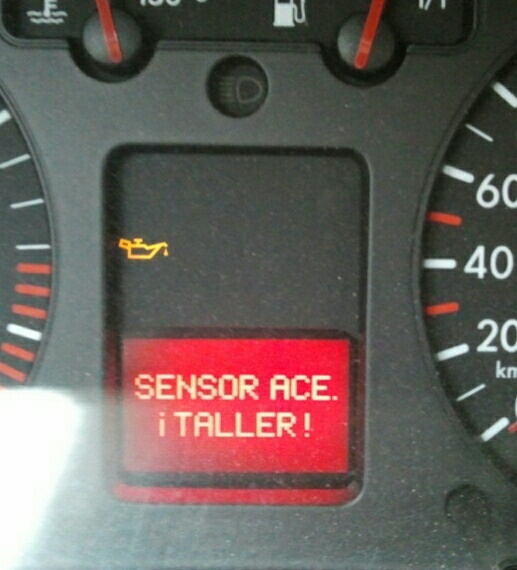
Resistors instead of light-emitting diodes, as on a photo, it is not
necessary to solder, we leave an empty place.
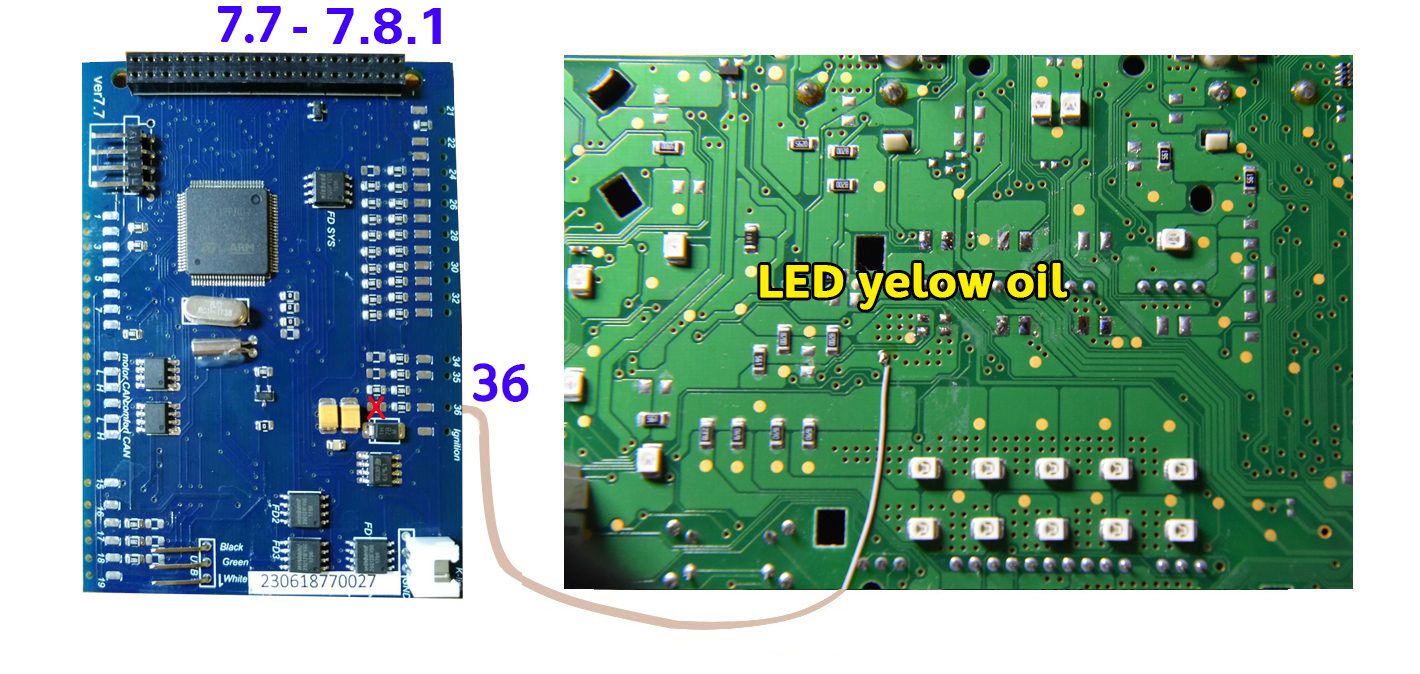
Important!
If you have half FIS or no display at all
It is necessary to remove 3kOhm (302 or
3001) resistor from the 36 pin MFD board
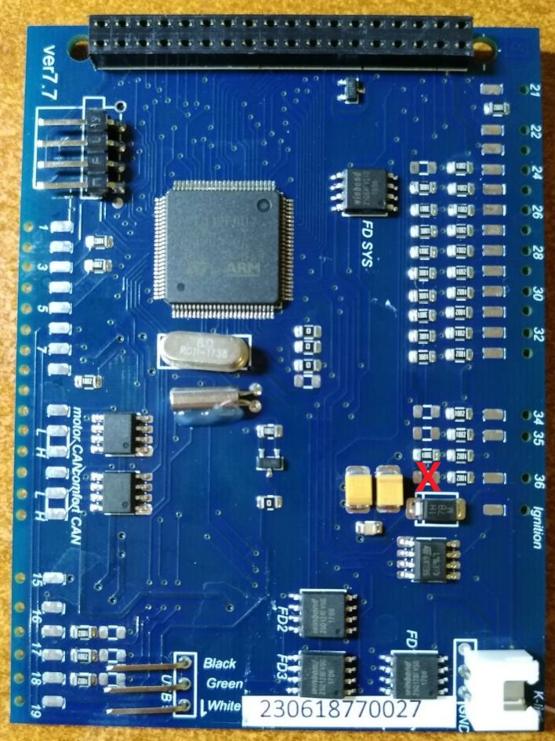
15. If
you are the lucky owner of Passat B5 released for the
North American
or USA market,
you
have to add a few SMD resistors to the board of the device.
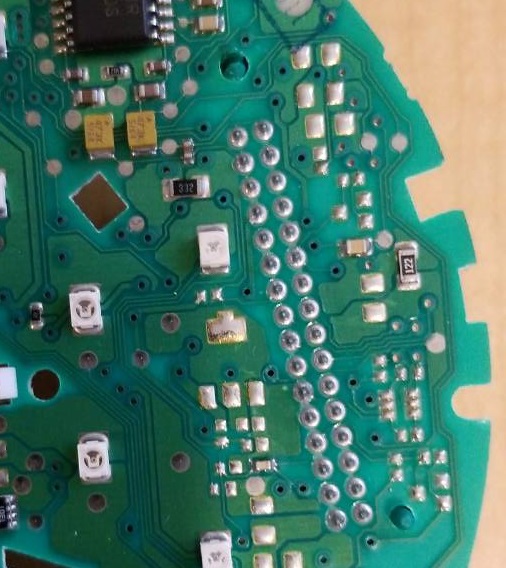
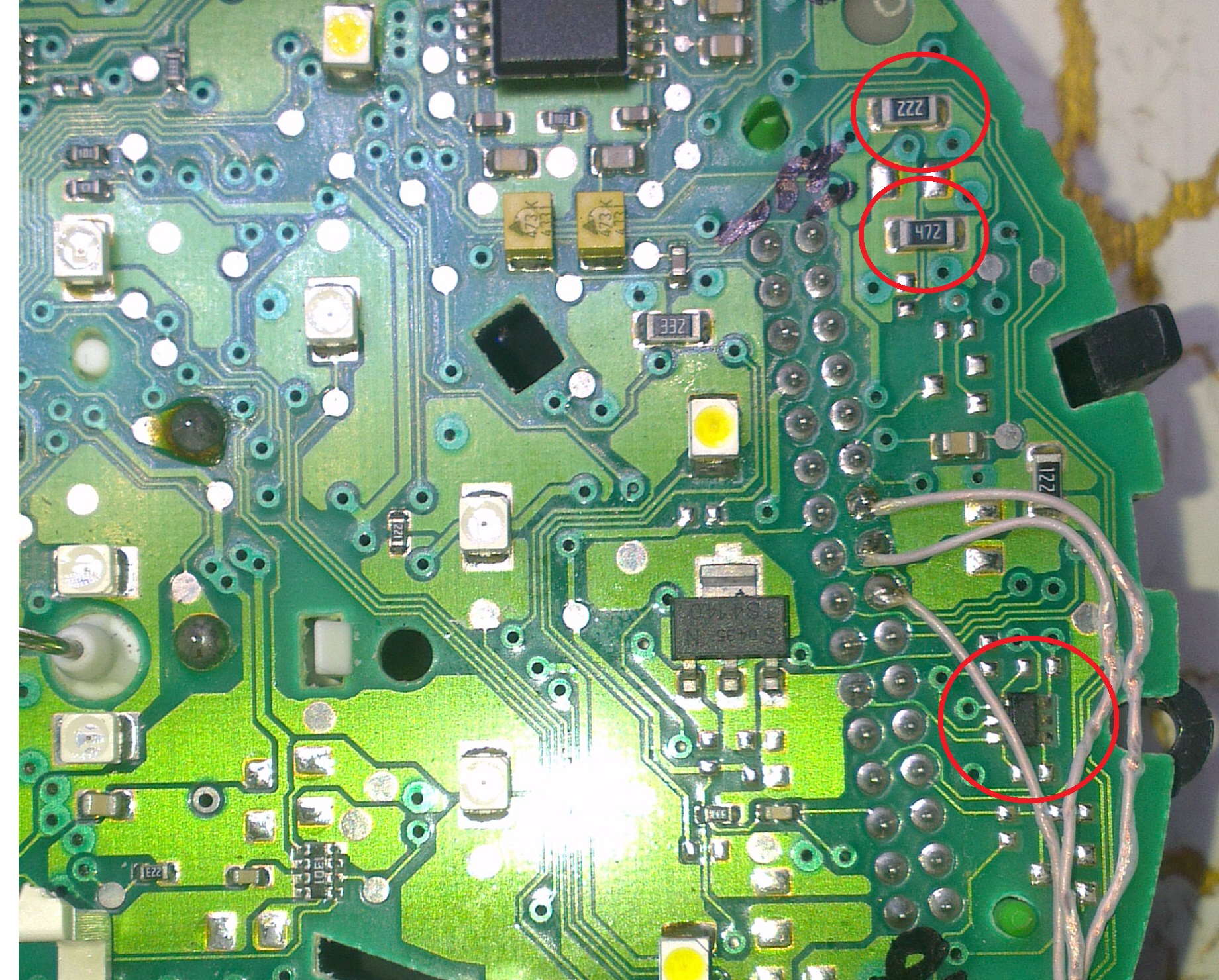
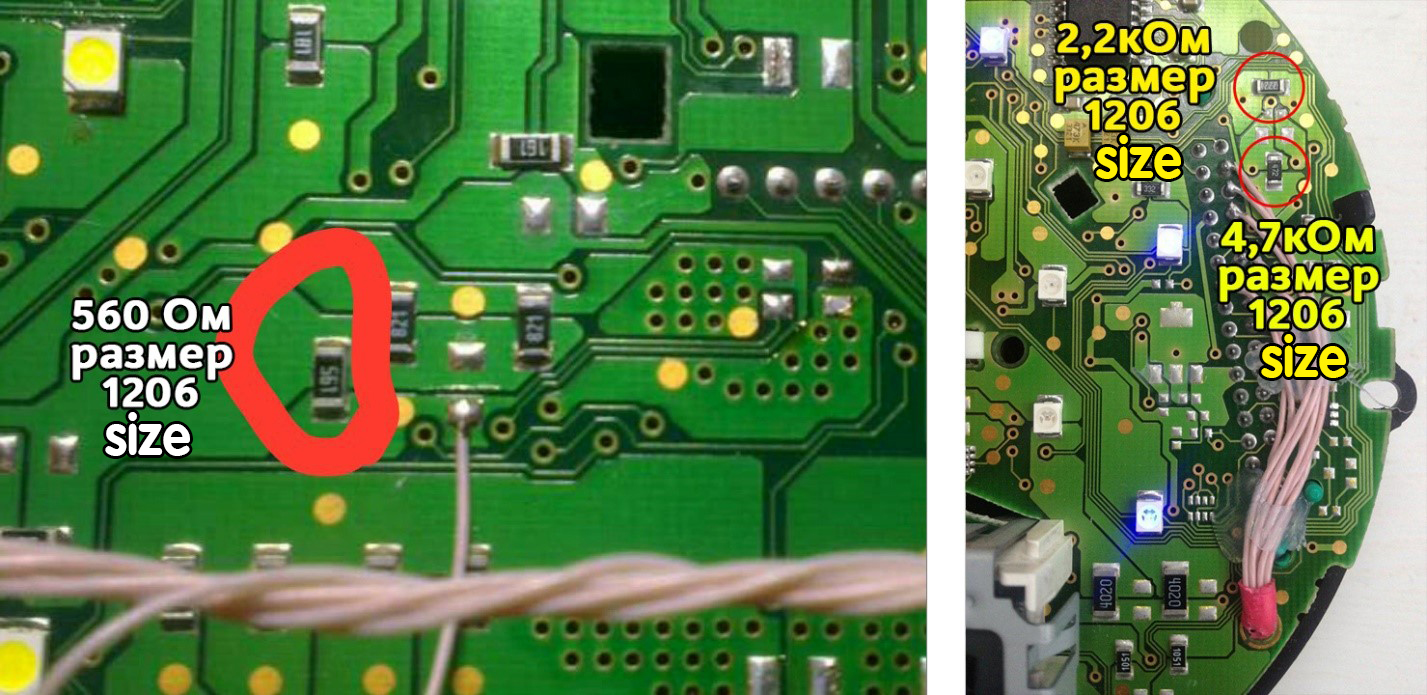
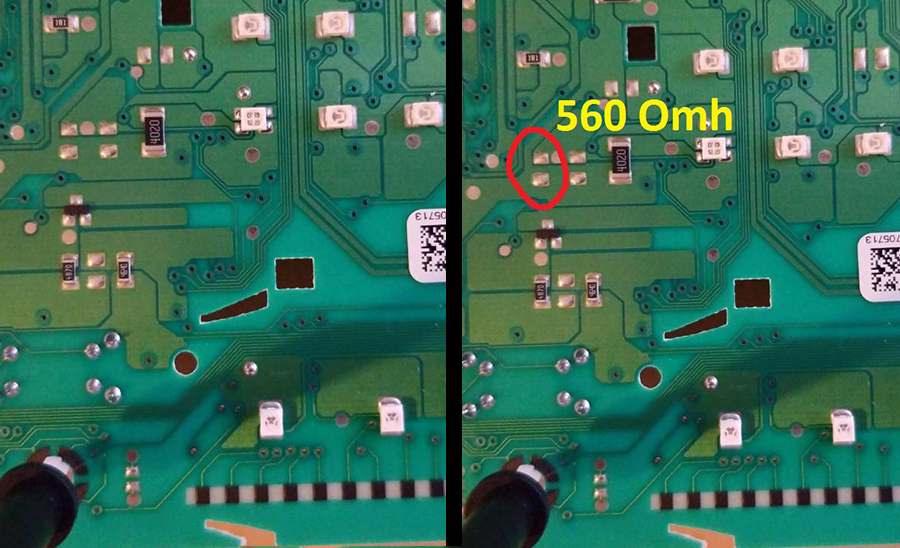
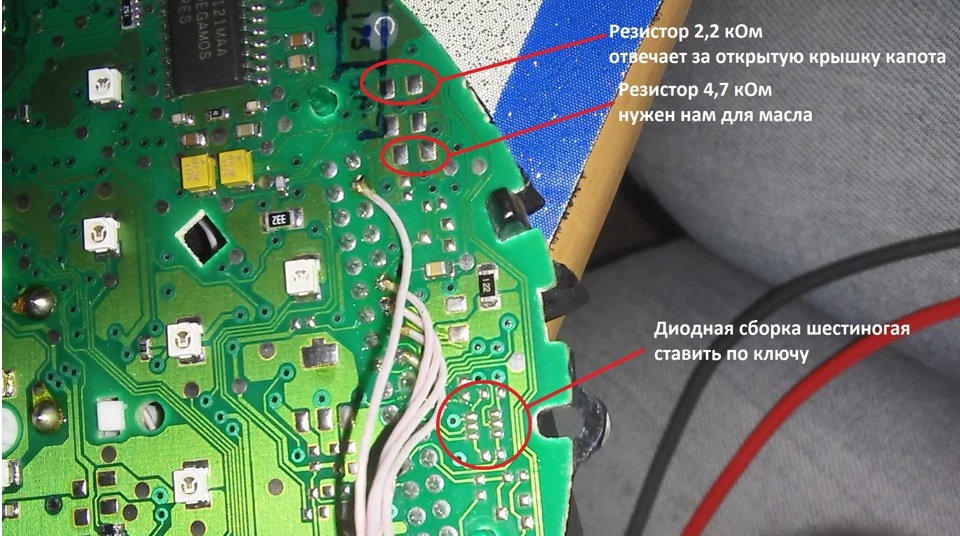
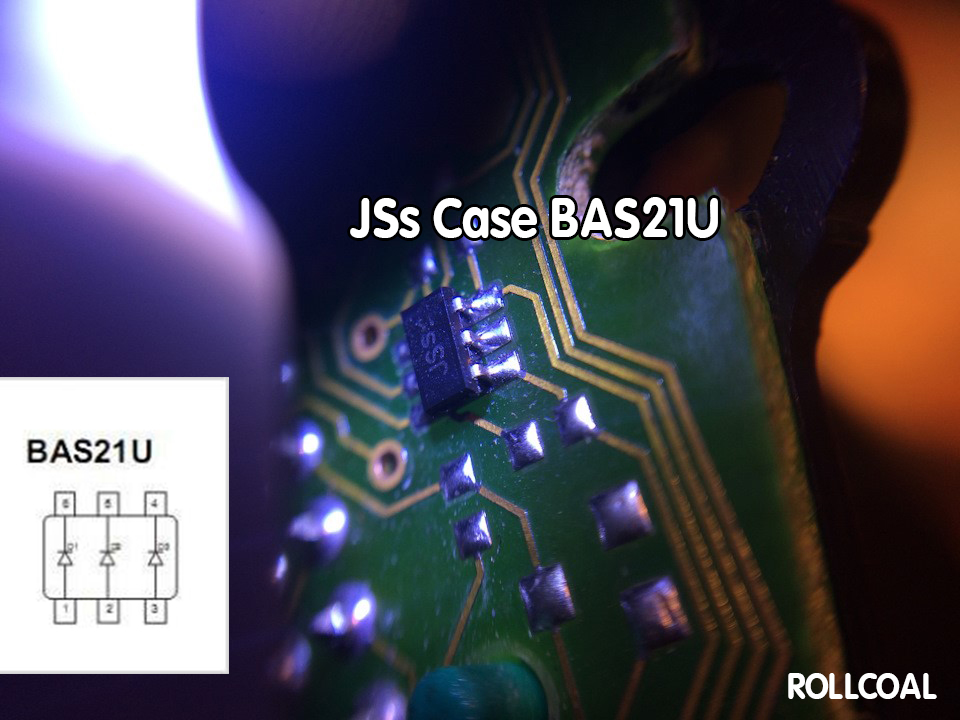
Since Americans do
not bother at all about the engine oil.
In
the cluster for the American market there
are no resistors responsible
for the level alarm and
Oil temperature, and the opening of the hood.
So
it's not right!

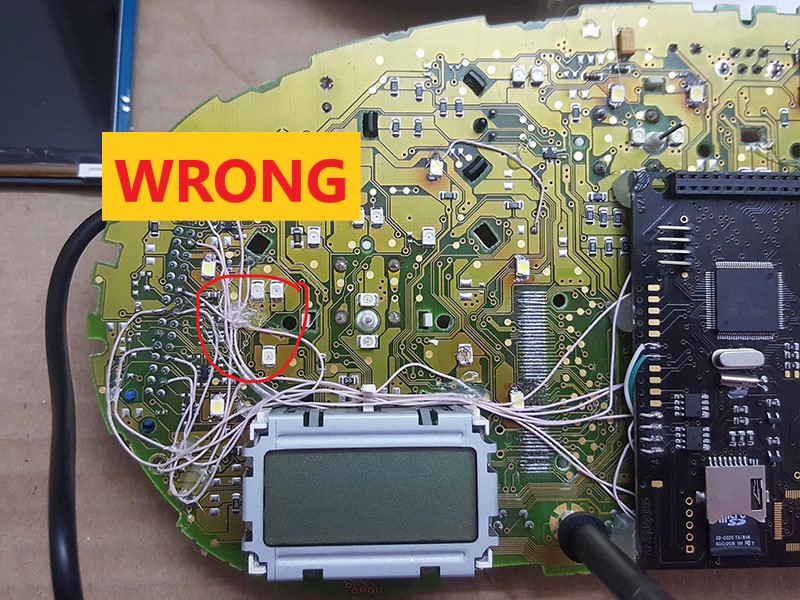
Attention!
18. Before
installing the power supply, you need to solder the wires to it
contacts + IN - IN and
+ OUT - OUT ,
then apply a current of 12V to + IN - IN ,
and connect
the + OUT - OUT wires
to the tester.
Now we need to
adjust the output current. Using
a small flat screwdriver
slowly
rotate
the special metal knob (figure 1 in the picture.) Clockwise
Arrow, until, at us
on the tester will not appear 5,5v in an output voltage.
Next we place the
power supply unit on the back side, we bring to its contacts the
wires from the blue connector.
9-pin of the blue connector
is connected to the e - IN on
the power supply board.
23 the leg of the blue connector
is connected to + IN On
the power supply board,
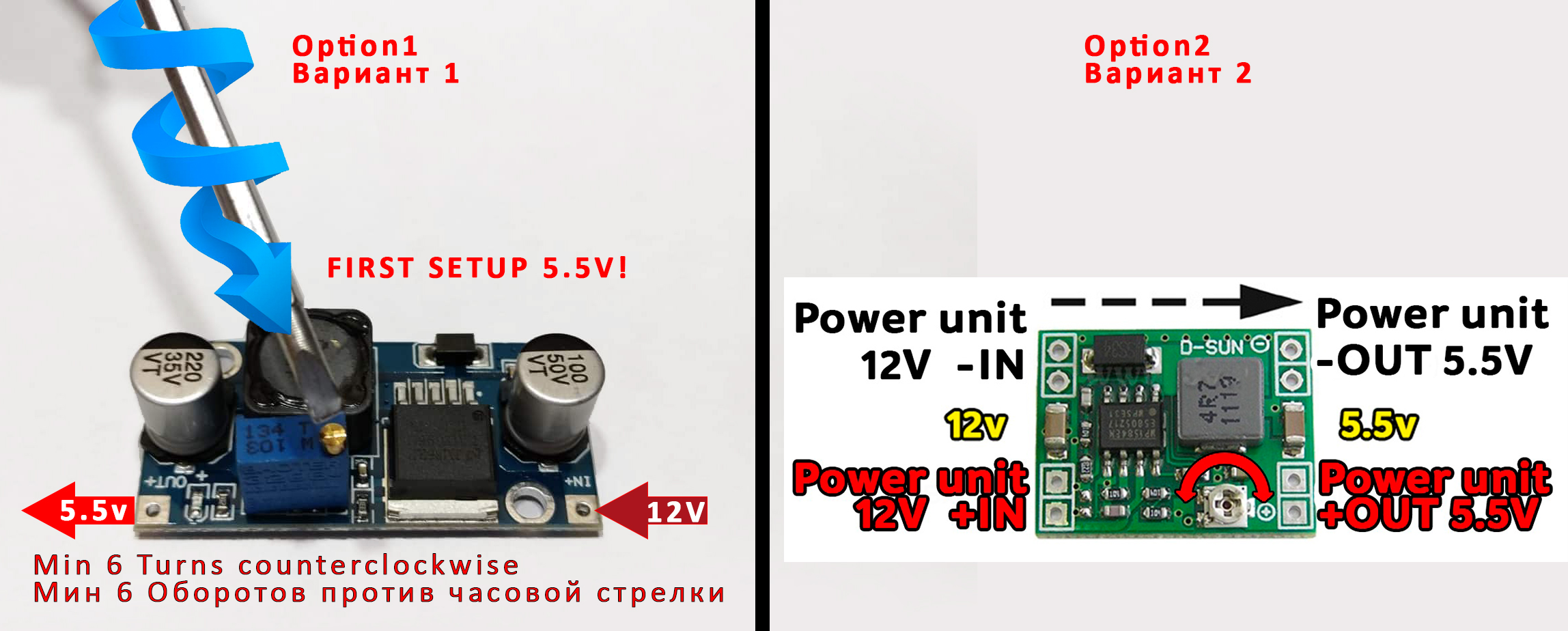
Contact
+ OUT Connects
to the 38 pin MFD
- OUT Connects
to 39 pin MFD
Choose the place of
installation of the power supply so that
during assembly it does not
interfere. Here
are the possible
Options:


Attention!
After wiring, lay it so that they do not interfere with further
assembly.
Need
to
call all contacts and check
on the table to avoid confusion anywhere.

20. Cut off the
main beam guide part.
On the red line.
Leave the
semicircle.

21.
Bite off the protruding part!

22. Before
installing the display, you need to glue two-way
cattle into three
layers on the back of the display to lock the display.
Attention, you do not need to attach modules to the board!
It is enough simply to remove an additional support from a
double-sided adhesive tape
without removing the protective layer
from the side of the module board.

The USB cable should be fixed with glue.
Red USB wire
do not use, cut it off.
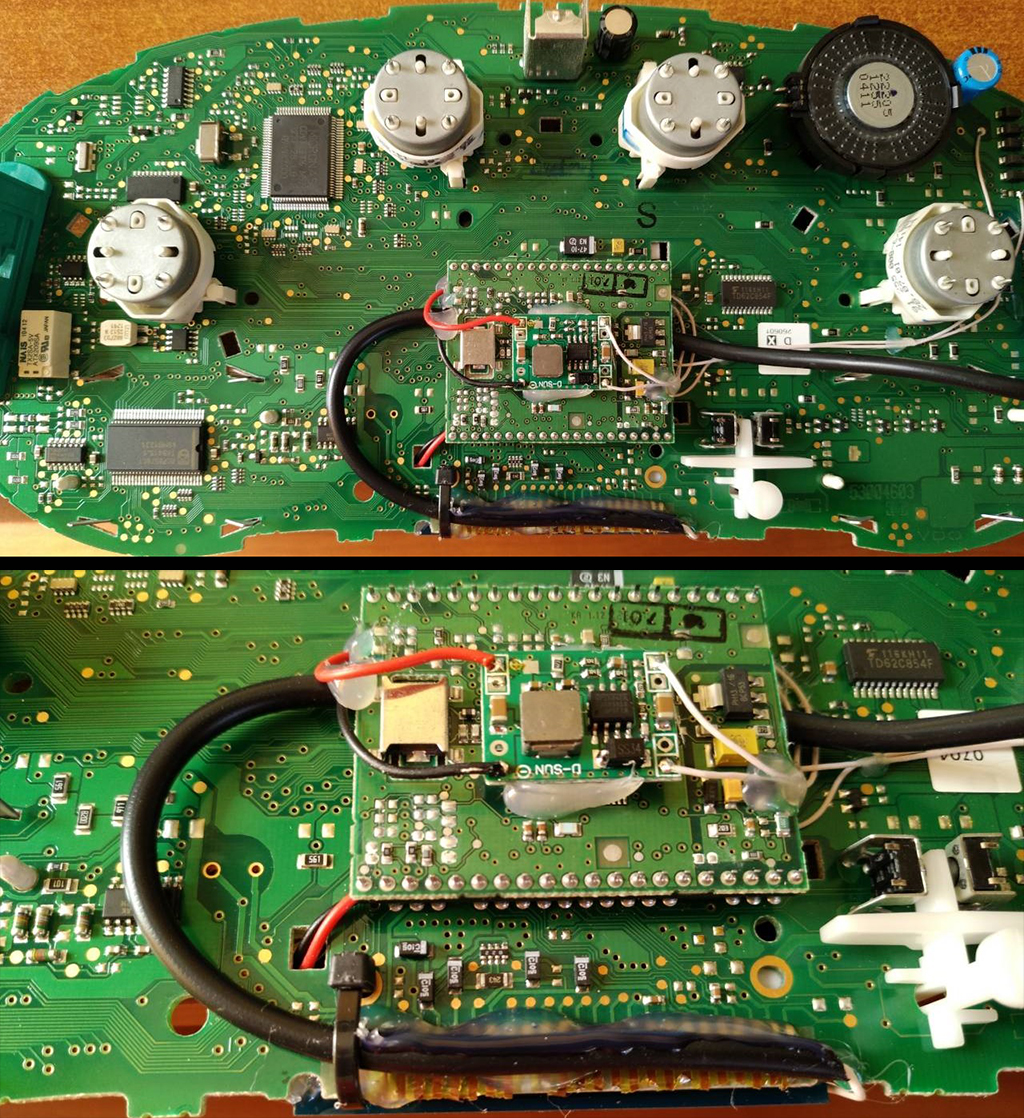
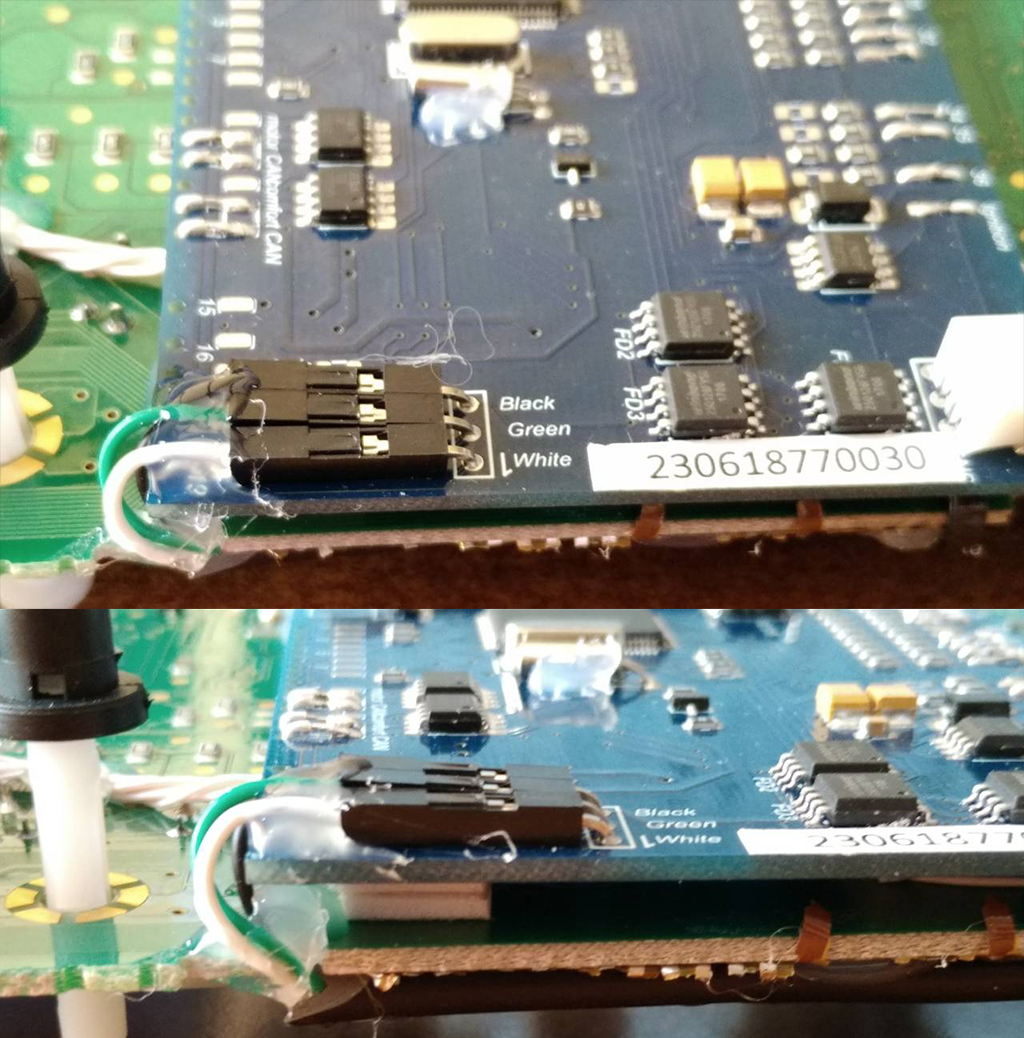
After you solder the wires
and set the display to its place,
you need to
test the MFD performance in the car to make sure everything is properly installed
and working well.

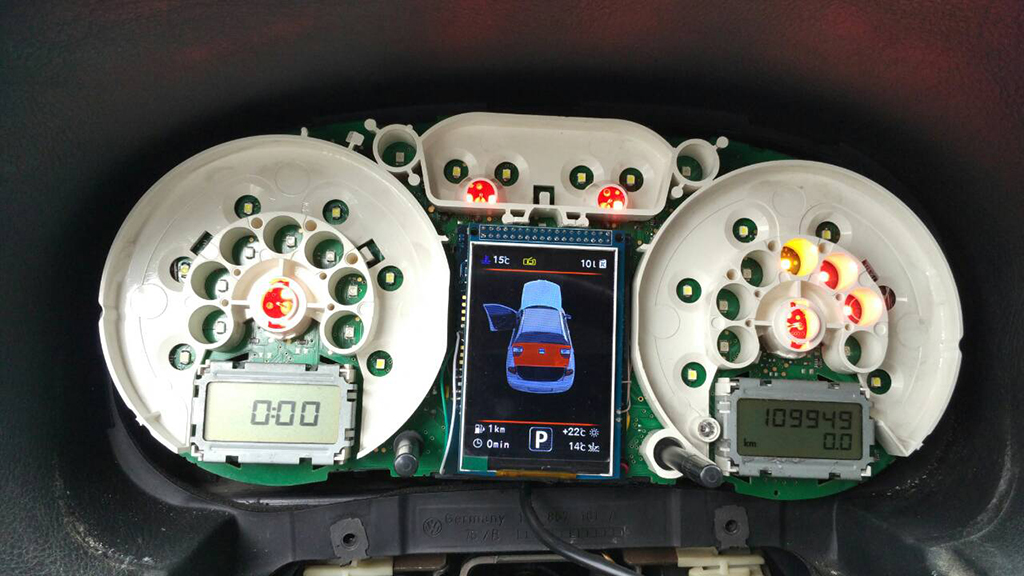
23. We take
double-sided adhesive tape on a foamy basis, cut the squares 1cm X 1cm.

24. We collect
these squares in 3 floors.

25. And we place
them so that we do not have anything to do with mounting the module
on the board

26. Place the
module so that it is placed in the window of the device

27. For greater reliability, when the module is already installed on
the board,
and you calibrated it in the window so that there were no distortions, it is
better to fix it.
Its hot glue along the edges of the module.

For a better alignment
of the display in the cluster mask window, you need to trim the
white plastic.
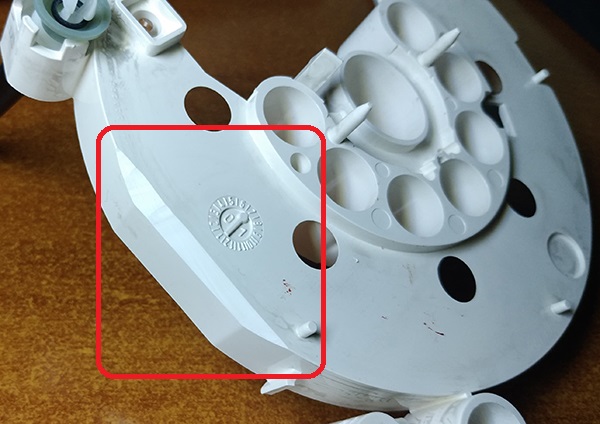
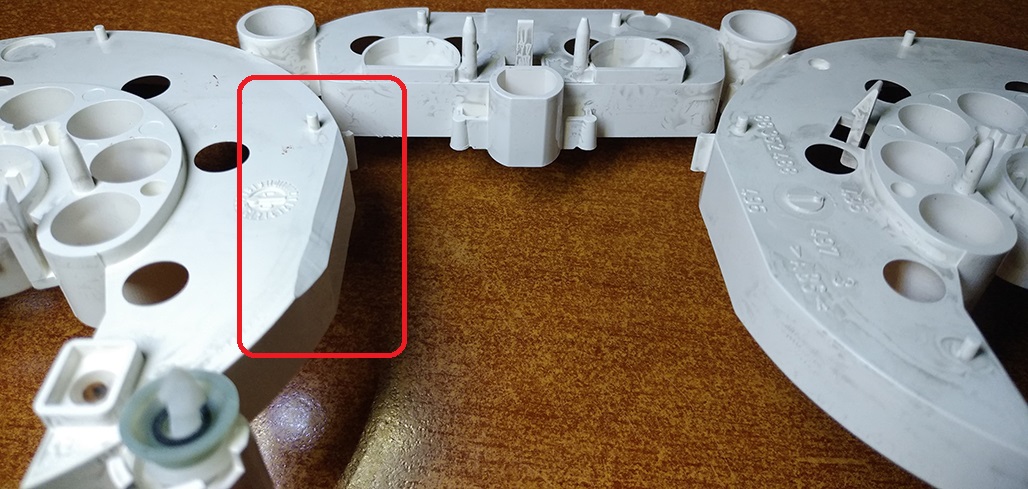
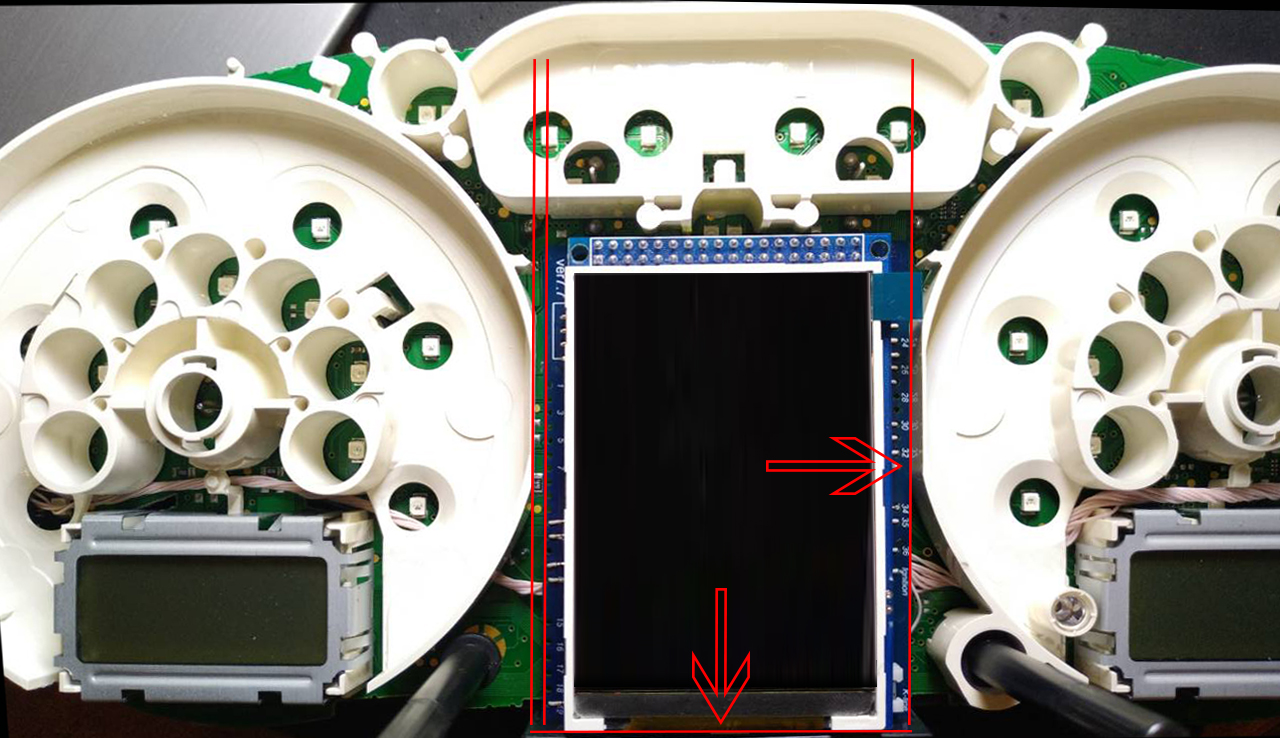

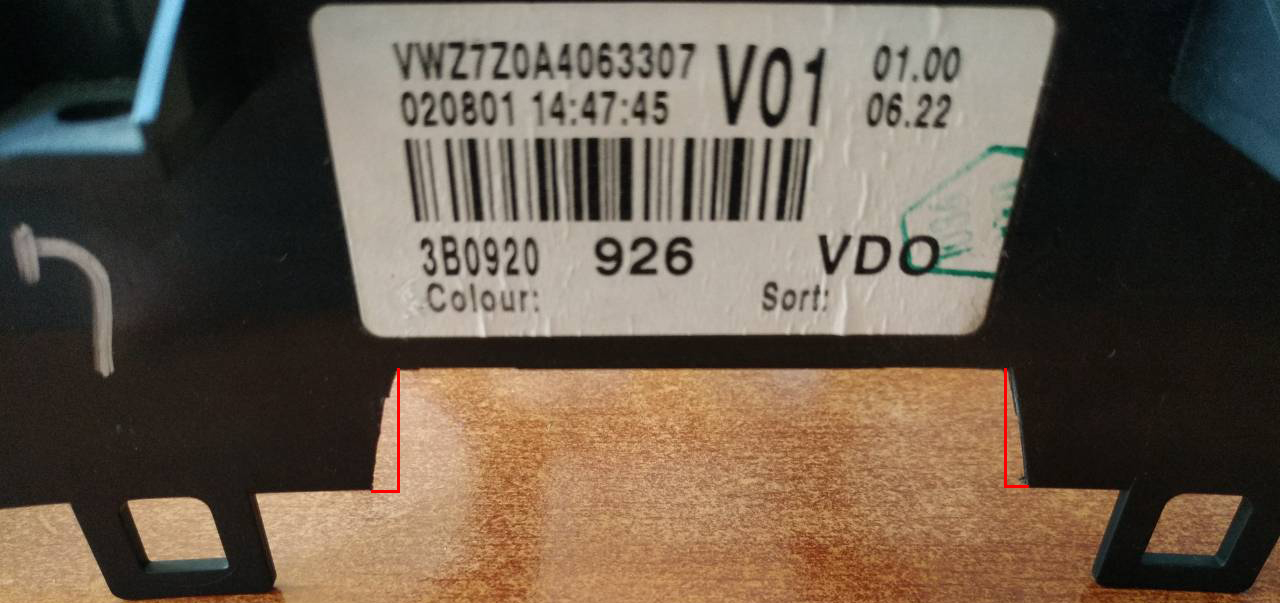
Next, you need
to glue the matte protective film so that the display does not glare
in the sun.

Attention!
Be sure to stick the film!
Otherwise, you may damage the display!


If you
have a 1J0 comfort unit installed.
Or your car
Seat Leon 1M
NECESSARY to stretch the wires from the comfort unit to the
appliance
The comfort block 9 -> on the terminals of the 8th leg of the device
(CAN-H Comfort) of the green connector.
The comfort block 6 -> on the terminals of the 9th leg of the device
(CAN-L Comfort) of the green connector.

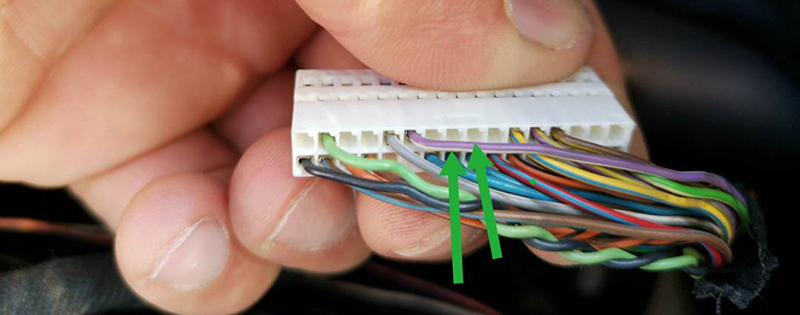

Installation of the IMMO3 cluster in a
vehicle with IMMO2
When installing the IMMO 3 instrumentation together with the comfort
unit 1J0 -It is necessary to remove 2 resistors
Going from 8 and 9 contacts of the green connector, and then connect
from 3DColorMFD
To terminals 8 (CAN-H Comfort) and 9 (CAN-L Comfort) of the green
connector.
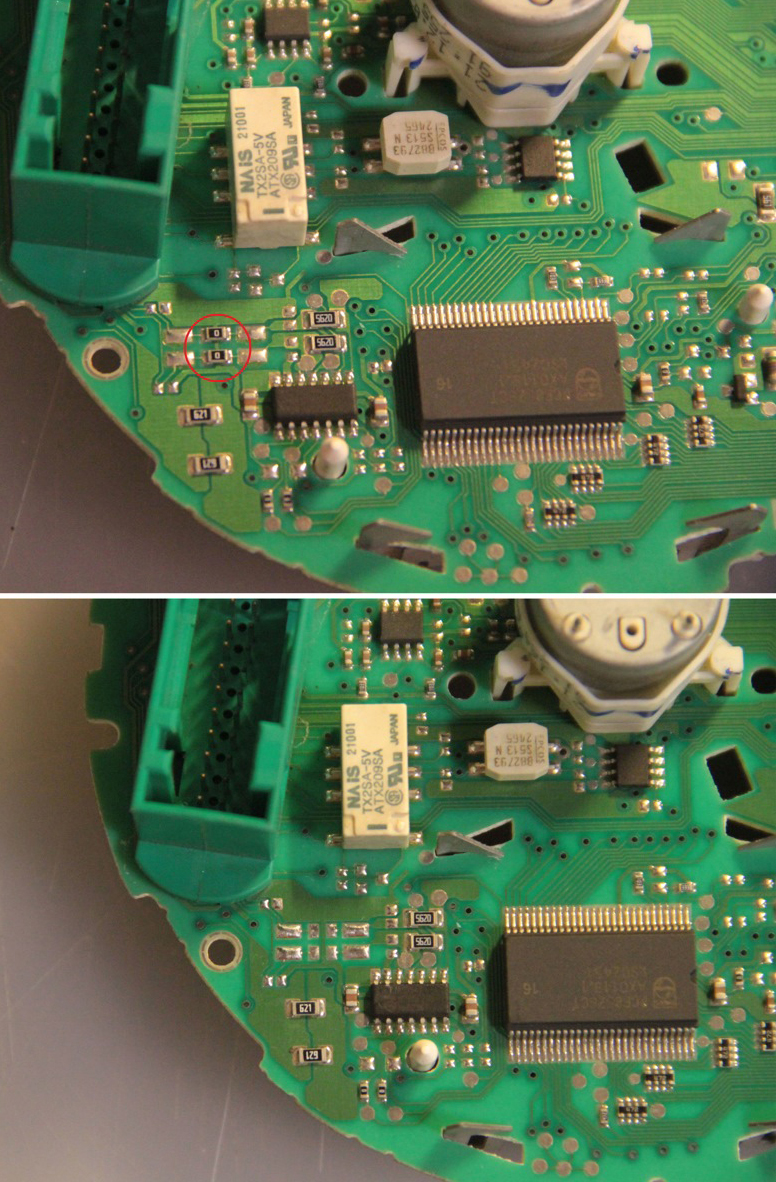
If
you Installating IMMO3 cluster in a
vehicle with IMMO2
Setting the ambient temperature sensor
Need activate ambiant temp in diag
Passat B5
You need to change 1ef from 08 to 01
line 0001E0 column F
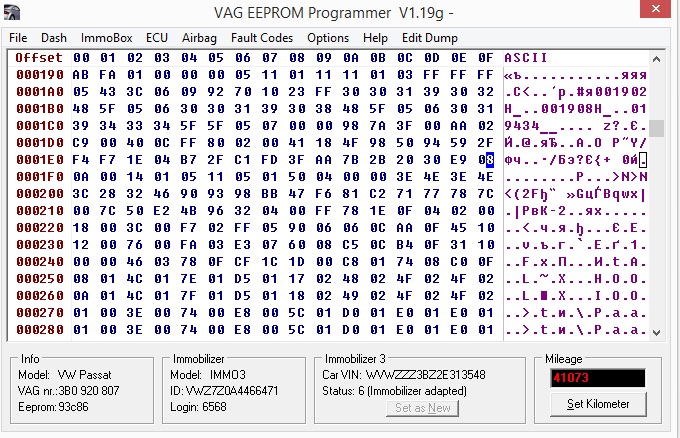
Golf 4
Cluster 1J0920806G no fis no show temp in dispay
You need to change 1e5 from 2B to 2F
line 0001E0 column 5
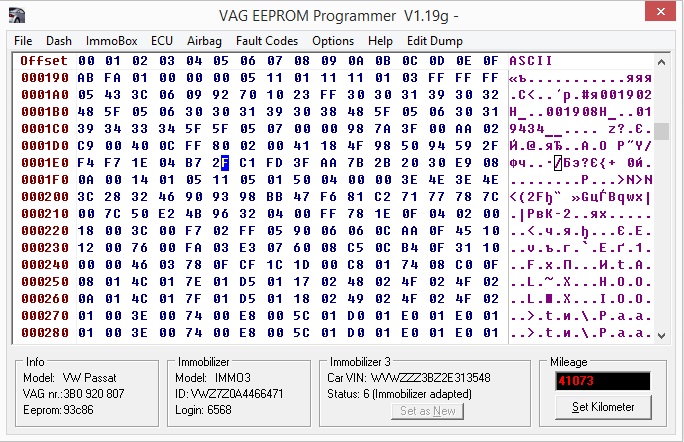
Change 2B in 2F and work
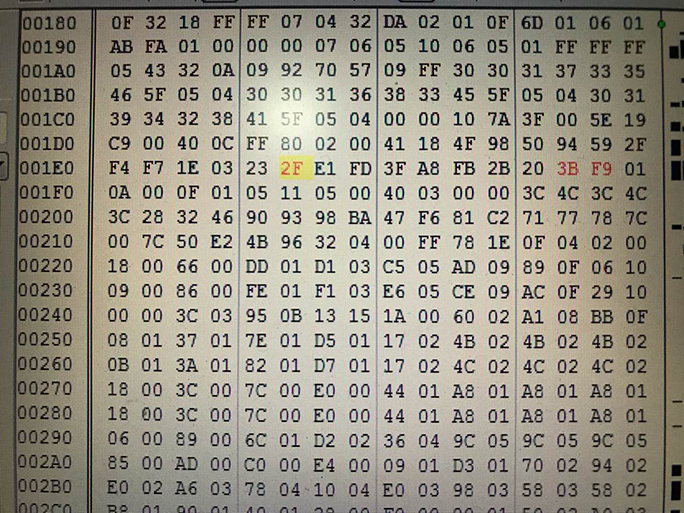
I changed that one 1E0 column 6 from 2B to 2F and it works
T
o connect the boost pressure control.
You will need to add one PIN to the dashboard 15
pin green connector.

And the second end of
the wire needs to be connected
the signal wire of
boost sensor,
on this wire at idle should be 1.6v,
with increasing PRM the voltage should
increase.
If your motor is not in the table, find the boost sensor under the
hood, it has 4 wires,
Use a multimeter to determine the signal wire, remember its color
and find this wire in the ECU connector
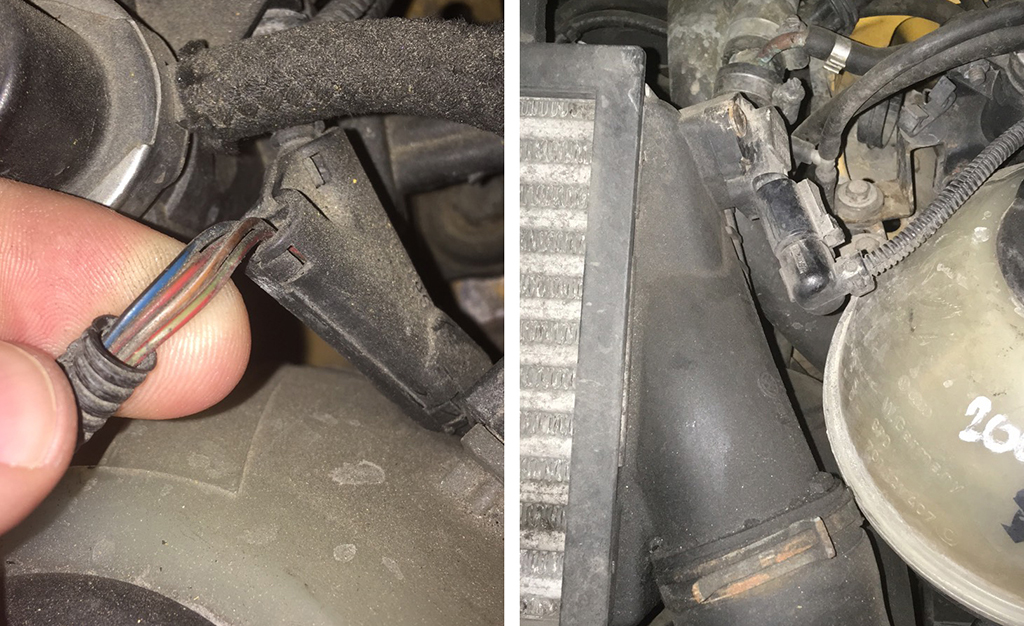
Usually it is blue - gray wire
(blue with a gray bar) to the incoming
On the 101st contact of a smaller brain connector.
On
diesel engines (AVB and others):
- 71st
contact of the motor
brain, green - red Wire
(green with a red stripe).
On
petrol (AWM and others):
- 101st
contact of the motor
brain, gray - blue wire
(gray with a blue stripe).
In
general, as far as I understand, at all B5-x diesel 1.9T
supercharging is connected to the 71st
And
the gasoline 1.8T is connected to the 101st contact. The
color of the wire can vary depending on the year / engine.
|
BES |
2.7T |
T121 |
101 pin |
blue-gray |
|
AJM |
1.9TD |
T121 |
71 pin |
yellow-black |
|
AKN |
2.5TD |
T121 |
71 pin |
yellow-red |
|
AUY |
1.9TD |
T121 |
71 pin |
yellow-black |
|
BQW |
2.0TD |
T94 |
78 pin |
green-red |
|
AWT |
1.8T |
T121 |
101 pin |
blue-gray |
|
AVG |
1.9TD |
T80 |
40 pin |
yellow-green |
|
AWM |
1.8T |
T121 |
101 pin |
blue-gray |
|
AFN |
1.9TD |
T121 |
70 pin |
green-red |
|
AWD |
1.8T |
T121 |
101 pin |
blue-gray |
|
AVB |
1.9TD |
T121 |
71 pin |
green-red |
|
AWP |
1.8T |
T121 |
101 pin |
violet-gray |
|
AVF |
1.9TD |
T121 |
71 pin |
green-red |
|
AUM |
1.8T |
T121 |
101 pin |
violet-gray |
|
AWX |
1.9TD |
T121 |
71 pin |
green-red |
|
AUQ |
1.8T |
T121 |
101 pin |
violet-gray |
|
AHF |
1.9TD |
T121 |
71 pin |
yellow-black |
|
ARZ |
1.8T |
T121 |
101 pin |
violet-gray |
|
ALH |
1.9TD |
T121 |
71 pin |
yellow-black |
|
ARX |
1.8T |
T121 |
101 pin |
violet-gray |
|
ARL |
1.9TD |
T121 |
71 pin |
yellow-black |
|
ANB |
1.8T |
T121 |
101 pin |
blue-gray |
|
ASV |
1.9TD |
T121 |
71 pin |
yellow-black |
|
APU |
1.8T |
T121 |
101 pin |
blue-gray |
|
ASZ |
1.9TD |
T121 |
71 pin |
yellow-black |
|
APB |
1.8T |
T121 |
101 pin |
blue-gray |
|
ATD |
1.9TD |
T121 |
71 pin |
yellow-black |
|
AMB |
1.8T |
T121 |
101 pin |
blue-gray |
|
AXR |
1.9TD |
T121 |
71 pin |
yellow-black |
|
|
|
|
|
|
|






And then we collect everything in
the reverse order without forgetting
to calibrate the
needles
with the help
of the WAG-com.
I. To
do this, connect the device to the machine without installing the
glass, connect the VAG-com,

Ii. Go
into the 17-unit dash panel

Iii. Select
test performers.

Iv. Choosing
in turn a tachometer, temperature and the rest, the arrows in turn
will be
Do a turn on
the whole scale, and then freeze on:


1. Tachometer
- 3 thousand revolutions

2. Pace. Coolant
- middle

3. Fuel
level - middle

4. Speedometer
- at 100 km / h

V. Then
turn off the power from the device!
Vi. And
set the arrows correctly rotating them in the desired direction.
Vii. Then
check everything again
Viii. You
can not turn the needles too quickly correcting the position, you can
to
damage the motors of the
needles
Ix. You
can not turn the arrows when there is power on the device.




















